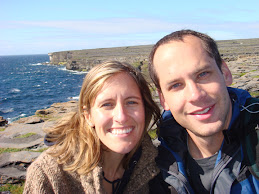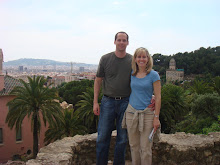Last fall, we asked several Spaniards we'd met in Galway the same question: If someone told you they only had time to visit one city in Spain, which would you recommend? I could see the near-tortuous contemplation on their faces, silently crying out, "Spain? Only one city? How can this be possible?" But when they finally made the grueling decision, they all gave the same answer: Barcelona. (They made their cases for additional visits to San Sebastian and Sevilla, of course.)
Barcelona was a little overwhelming to me at first. It's big, bold and eclectic, a sprawling city so large that only a poster-size map would afford you the ability to see all sections of town, especially the tiny little Gothic Quarter passages. On many occasions, we spent 15 minutes walking underground in the never-ending metro tunnels before reaching the platform. Hordes of tourists swarm the streets. But if you like to walk (and we do) and you love food, sparkling wine, diverse architecture, music and the bustling pulse of an oceanside city (ditto here), Barcelona's charms soon overthrow the shock of its stature. Once you get your bearings, learn the ropes and accept the fact that millions of people like you flock to this amazing maritime city every year, you will have a fabulous time. We certainly did.
Barcelona is the second-largest city in Spain and the capital of Catalonia, an autonomous region in northeastern Spain, bordering France and the Andorra region of Spain. They have their own government, cultural traditions, etc., even a language, Catalan, quite different from Spanish, but since we don't speak Spanish, we didn't really notice. :)

We flew Ryanair from Shannon to Girona and took a bus to the main station, Barcelona Nord, in typical Ryanair fashion. We stayed at a house converted into guest rooms called Fashion House, which was located half way between the bus station and the top of La Rambla. Fashion House was a great location and great price, but a little too noisy for us.
We spent our first day walking around, getting a handle locations and distances, while letting sensory overload welcome us in grand Barcelona style. A walk down La Rambla -- passing vendors selling ducks, chickens, turtles, parakeets, ferets, bunnies and more as well as painted street performers miming for money -- led us to La Boqueria, a highlight of the trip. This market blew our minds! It dates back to the early 1200s. You could spend at least a half-day hanging out at the tapas bar counters, sipping on cava and nibbling on croquetas. Just check out our pictures. We ate fresh, grilled calamari and a plate of sauteed mushrooms with our cava, then moved along to Bar Pinotxo, where I waited in line for heavenly morel mushroom croquetas. We bought some chocolates and a Kiwi smoothie before taking a walk around the new boardwalk area by the Aquarium and the port where all the cruise ships dock.
Then we walked through part of the Barri Gothic (Gothic Quarter) and toured the Cathedral of Santa Eulalia with its beautiful cloisters and fountain surrounded by geese. Unfortunately, there is a lot of restoration work happening here now, so we couldn't get a good shot of the exterior. We spent the rest of the day walking over to, and up to Montjuic, the mountainous area where most of the 1992 Summer Olympics buildings were constructed. (We'd hoped to take the gondola from the port over to the mountain, but got turned away by one of the gondola workers even though the guide books said it closed three hours later.) We checked out the stadium, auditorium and the gorgeous views from the plaza in front of the National Art Museum of Catalunya . We also visited a place we did not realize was a theme park called Poble Espanyol. It's a village of tourist shops with all the buildings designed to display different types of Spanish architecture. The buildings were very pretty, though not a highlight of the trip. That night, we ate a hardy, traditional Catalonian dinner at Meson David, a restaurant that had been recommended to us for its value. We finished off the night with mojitos (is there any city that doesn't feature them on every menu?) at this really funky bar that reminded me of a less-commercial version of Rainforest Cafe called El Bosc de les Fades, and we sipped our mojitos by a tree trunk, under its branches, next to the pond adorned with plastic dolls. Crazy place.
The behemoth Sagrada Familia beckoned on our second day, the Antoni Gaudi Catholic church that has been under construction since 1882. He lived his last 16 years inside the church while building it and is buried in the crypt. We'll let the pictures do the rest of the talking; this place is insane. Tourists stand in line for sometimes two hours to ride the elevators up to one of the spires high above the city. That's the only way to go up. We got there at opening and still had to wait nearly one hour. The highlight was the climb down from the top, where we got to stop off at some open terraces jetting out from the side of the church. (Scary!)
Architect Antoni Gaudi left his Modernisme imprint all over Barcelona, and Barcelonians, as well as the rest of the world, will be grateful for thousands of years to come. Once you see a Gaudi building flanked by a traditional business building -- the mosaic tiles and curved lines juxtaposed with bland walls of stone and straight lines -- you want to spend the rest of your time in Barcelona seeing his masterpieces with your own eyes. I know I did.
We went to a disappointing market about 15 minutes from the church (really just a flea market), then doubled back and hopped on the Bus Turistic outside Sagrada (no small feat -- we had to wait in line for at least 30-40 minutes) and rode around during a light rain storm, listening to the history and seeing many sights on the north side of town. Our next Gaudi building we'd hoped to see was Casa Batlló, sadly closed early when we stopped by on Saturday, so we took exterior pictures of it and Gaudi's nearby Casa Milà, then strolled down the fashionable Passeig de Gracia and had tapas and cava at an sidewalk cafe. Afterwards, we found a local artists market happening on Avinguda del Porta de l'Angel, where we also watched a woman dancing flamenco, an amazing tap dancer, and Damon bought me a new bathing suit for our coming Greece trip. We stopped by the Santa Maria del Mar church, then tried to get into the Picasso Museum a couple of times that night (always LONG lines), then had a wonderful dinner at Senyor Paralleda, just east of the Gothic Quarter, before heading down to Placa Reial for an authentic flamenco performance, another highlight of the trip.
We had a lot of ground to cover on our last day. As soon as they opened the doors at Casa Batlló on Sunday morning, we started our tour. The curves, funky windows, stairwells, mosaic tiles and rooftop terrace were a trip. Check out the photos. We also stumbled upon a big race happening on the streets of Barcelona and took a few photos on our way to the Picasso Museum in the Gothic Quarter, determined to get in. We arrived just before opening, and there was still a line of at least 50 people. But we learned that this particular Sunday was free-entry day, so the line went fast. This museum has one of the most extensive collections of artworks by the 20th century Spanish artist Pablo Picasso. I would have liked to have spent more time there, but we booked two seats at a classical concert at Palau de la Música Catalana, mainly to see the interior of this stunning Art Nouveau masterpiece. The music was lovely but the setting was unreal.
Our next Gaudi stop was the Park Güell, a public park on the west side of the city which was originally supposed to be a housing development commissioned by Count Eusebi Güell. It is a UNESCO Heritage Site. We absolutely loved the walking trails, cave-like tunnels, plants, mosaic tile benches and more. We shared a sandwich in the park before hopping on the tourist bus and going to Tibidabo, the highest-point above Barcelona. There is an amusement park here will rides perched on the cliffs -- amazing! -- and you have to either drive a car or ride the funicular to the park, which we did. We treated ourselves to a carmel apple while watching the kids enjoy the rides -- what a surprise we found when I bit into the apple and found that Catalonians like to harden the caramel on their apples!
A little rain hampered our photography opportunities, so we climbed to the top of Temple Expiatori del Sagrat Cor -- one of these best-kept secret type of places we discovered. We have no idea why more tourists don't pay the 2 euros to take the elevator to the top of this church above Tibidabo, but the views were amazing. We waited for the skies to clear and got some great shots, before finding a terrace bar overlooking the city to stop for a glass of cava. We road the tourist bus on two separate routes, finishing near Barceloneta, an oceanfront neighborhood where we had paella and arros negre, two traditional Spanish dishes, to celebrate our fanastic 2.5 days in Barcelona. I think 4-5 days would be the right amount of time to spend in Barcelona, so hopefully someday, we'll return. Hanging out in the market, sidewalk tapas cafes and beachfront bars sounds like the way I'd like to spend my next trip to Barcelona.





















